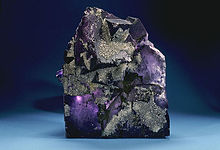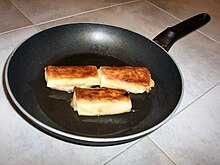氟化物:修订间差异
翻译条目 |
(没有差异)
|
2008年4月12日 (六) 13:36的版本
模板参数错误!(代码34)
|
氟化物指含负价氟的有机或无机化合物。与其他卤素类似,氟生成单负阴离子(氟离子F-)。氟可与除He、Ne和Ar[來源請求]外的所有元素形成二元化合物。从致命毒素沙林到药品依法韦仑,从难熔的氟化钙到反应性很强的四氟化硫都属于氟化物的范畴。
例子

无机氟化物的水溶液含有F-和氟化氢根离子HF2-。[1]少数无机氟化物溶于水而不显著水解。无机氟化物的例子有氢氟酸(HF)、氟化钠(NaF)和六氟化铀(UF6)。从反应活性上看,氟化物与氯化物和其他卤化物有显著不同,由于半径/电荷比小的缘故而溶剂化倾向更强,更趋近于氢氧化物。Si-F键属于单键中键能较高的一类,其他硅卤化物则很容易水解。因此有机合成中可以用氟化铯来脱去含硅保护基。
氟化物矿物有很多,其中商业上比较重要的是萤石和氟磷灰石。在天然饮用水和食物中都有低浓度的氟化物存在,而地下水中的氟含量则要高一些。海水中平均为1.3ppm[2](1.2~1.5ppm),淡水中的则为0.01-0.3 ppm。[3]
应用
Fluorides are pervasive in modern technology. Hydrofluoric acid is the most important fluoride synthesized. It is principally used in the production of fluorocarbons and aluminium fluorides. Hydrofluoric acid has a variety of specialized applications, including its ability to dissolve glass.[4]
有机合成
Fluoride reagents are significant in synthetic organic chemistry. Due to the affinity of silicon for fluoride, and the ability of silicon to expand its coordination number, silyl ether protecting groups can be easily removed by the fluoride sources such as sodium fluoride and tetra-n-butylammonium fluoride (TBAF).
酶抑制剂
In biochemistry, fluoride salts are commonly used to inhibit the activity of phosphatases, such as serine/threonine phosphatases.[5] It may do this by replacing the nucleophilic hydroxyl ion in these enzymes' active sites.[6] Beryllium fluoride and aluminium fluoride are also used as phosphatase inhibitors, since these compounds are structural mimics of the phosphate group and can act as analogues of the transition state of the reaction.[7][8]
无机材料
Sulfur hexafluoride is an inert, nontoxic insulator that is used in electrical transformers. Uranium hexafluoride is used in the separation of isotopes of uranium between the fissile isotope U-235 and the non-fissile isotope U-238 in preparation of nuclear reactor fuel and atomic bombs.

含氟聚合物
Fluoropolymers such as polytetrafluoroethylene, Teflon, are used as chemically inert and biocompatible materials for a variety of applications, including as surgical implants such as coronary bypass grafts,[9] and a replacement for soft tissue in cosmetic and reconstructive surgery.[10] These compounds are also commonly used as non-stick surfaces in cookware and bakeware, and the fluoropolymer fabric Gore-Tex used in breathable garments for outdoor use.
Cavity-prevention
Fluoride-containing compounds are used in topical and systemic fluoride therapy for preventing tooth decay. They are used for water fluoridation and in many products associated with oral hygiene.[11] Originally, sodium fluoride was used to fluoridate water, however, hexafluorosilicic acid (H2SiF6) and its salt sodium hexafluorosilicate (Na2SiF6) are more commonly used additives, especially in the United States. The fluoridation of water, considered by the U.S. CDC as "one of 10 great public health achievements of the 20th century,"[12] prevents tooth decay.[13][14] In some countries where large, centralized water systems are uncommon, fluoride is delivered to the populace by fluoridating table salt. Fluoridation of water is not without critics, however (see Water fluoridation controversy).[15]

生物医药应用
Positron emission tomography is commonly carried out using fluoride-containing pharmaceuticals such as fluorodeoxyglucose, which is labelled with the radioactive isotope fluorine-18 that emits positrons when it decays into 18O.
Fluorine is also part of a large variety of drugs including: antipsychotics such as fluphenazine, HIV protease inhibitors such as tipranavir, antibiotics such as ofloxacin and trovafloxacin, and anesthetics such as halothane.[16] These atoms are incorporated in the drug structures to reduce drug metabolism, as the strong C-F bond resists deactivation in the liver by cytochrome P450 oxidases.[17]
毒性
Fluoride-containing compounds are so diverse that it is not possible to generalize on their toxicity, which depends on their reactivity and structure, and in the case of salts, their solubility and ability to release fluoride ions. Soluble fluoride salts, of which NaF is the most common, are mildly toxic but have resulted in both accidental and suicidal deaths from acute poisoning.[4] While the minimum fatal dose in humans is not known, a case of a fatal poisoning of an adult with 4 grams of NaF is documented.[18] Sodium fluorosilicate, Na2SiF6 with its higher fluorine content, can cause death with as little as 0.2 g. The fatal period ranges from 5 min to 12 hours.[18] The mechanism of toxicity involves the combination of the fluoride anion with the calcium ions in the blood to form insoluble calcium fluoride, resulting in hypocalcemia; calcium is indispensable for the function of the nervous system, and the condition can be fatal. Treatment may involve oral administration of dilute calcium hydroxide or calcium chloride to prevent further absorption, and injection of calcium gluconate to increase the calcium levels in the blood.[18] Hydrogen fluoride is more dangerous than salts such as NaF because it is corrosive and volatile, and can result in fatal exposure through inhalation or contact with the skin; calcium gluconate gel is the usual antidote.[19]
A few organofluorine compounds are extremely toxic, such as organophosphates like sarin and diisopropylfluorophosphate that react with the cholinesterase enzyme at neuromuscular junctions and thus block the transmission of nerve impulses to the muscles.[20] Here, a reactive fluorine-phosphorous bond in the inhibitor is the site of nucleophilic attack by a serine residue in the enzyme's active site, causing the loss of a F- ion and alkylation and inactivation of the enzyme.
While PTFE itself is chemically inert and non-toxic, it begins to deteriorate after the temperature of cookware reaches about 500 °F (260 °C), and decompose above 660 °F (350 °C).[21] These degradation products can be lethal to birds, and can cause flu-like symptoms in humans.[21] In comparison, cooking fats, oils, and butter will begin to scorch and smoke at about 392 °F (200 °C), and meat is usually fried between 400–450 °F (200–230 °C), but empty cookware can exceed this temperature if left unattended on a hot burner.
A 1959 study, (conducted before the Food and Drug Administration approved the material for use in food processing equipment) showed that the toxicity of fumes given off by the coated pan on dry heating was less than that of fumes given off by ordinary cooking oils.[22]
参见
参考资料
- ^ Holleman, A. F.; Wiberg, E. "Inorganic Chemistry" Academic Press: San Diego, 2001. ISBN 0-12-352651-5.
- ^ Fluoride in Drinking-water: Background document for development of WHO Guidelines for Drinking-water Quality. World Health Organization, 2004, page 2. Page accessed on February 22, 2007.
- ^ Environmental Health Criteria 227: Fluorides. World Health Organization, 2002, page 38. Page accessed on February 22, 2007.
- ^ 4.0 4.1 Jean Aigueperse, Paul Mollard, Didier Devilliers, Marius Chemla, Robert Faron, Renée Romano, Jean Pierre Cuer, “Fluorine Compounds, Inorganic” in Ullmann’s Encyclopedia of Industrial Chemistry 2005 Wiley-VCH, Weinheim. DOI 10.1002/14356007.a11 307
- ^ Nakai C, Thomas JA. Properties of a phosphoprotein phosphatase from bovine heart with activity on glycogen synthase, phosphorylase, and histone. J. Biol. Chem. 1974, 249 (20): 6459–67. PMID 4370977.
- ^ Schenk G, Elliott TW, Leung E; et al. Crystal structures of a purple acid phosphatase, representing different steps of this enzyme's catalytic cycle. BMC Struct. Biol. 2008, 8 (1): 6. PMID 18234116. doi:10.1186/1472-6807-8-6.
- ^ Wang W, Cho HS, Kim R; et al. Structural characterization of the reaction pathway in phosphoserine phosphatase: crystallographic "snapshots" of intermediate states. J. Mol. Biol. 2002, 319 (2): 421–31. PMID 12051918. doi:10.1016/S0022-2836(02)00324-8.
- ^ Cho H, Wang W, Kim R; et al. BeF(3)(-) acts as a phosphate analog in proteins phosphorylated on aspartate: structure of a BeF(3)(-) complex with phosphoserine phosphatase. Proc. Natl. Acad. Sci. U.S.A. 2001, 98 (15): 8525–30. PMID 11438683. doi:10.1073/pnas.131213698.
- ^ Kannan RY, Salacinski HJ, Butler PE, Hamilton G, Seifalian AM. Current status of prosthetic bypass grafts: a review. J. Biomed. Mater. Res. Part B Appl. Biomater. 2005, 74 (1): 570–81. PMID 15889440. doi:10.1002/jbm.b.30247.
- ^ Singh S, Baker JL. Use of expanded polytetrafluoroethylene in aesthetic surgery of the face. Clin Plast Surg. 2000, 27 (4): 579–93. PMID 11039891.
- ^ McDonagh M S, Whiting P F, Wilson P M, Sutton A J, Chestnutt I, Cooper J, Misso K, Bradley M, Treasure E, & Kleijnen J. Systematic review of water fluoridation. British Medical Journal. 2000, 321 (7265): 855–859. doi:10.1136/bmj.321.7265.855.
- ^ [1]
- ^ Griffin SO, Regnier E, Griffin PM, Huntley V. Effectiveness of fluoride in preventing caries in adults. J. Dent. Res. 2007, 86 (5): 410–5. PMID 17452559.
- ^ Winston AE, Bhaskar SN. Caries prevention in the 21st century. J Am Dent Assoc. 1998, 129 (11): 1579–87. PMID 9818575.
- ^ Newbrun E. The fluoridation war: a scientific dispute or a religious argument?. J Public Health Dent. 1996, 56 (5 Spec No): 246–52. PMID 9034969.
- ^ Park BK, Kitteringham NR, O'Neill PM. Metabolism of fluorine-containing drugs. Annu. Rev. Pharmacol. Toxicol. 2001, 41: 443–70. PMID 11264465. doi:10.1146/annurev.pharmtox.41.1.443.
- ^ Fisher MB, Henne KR, Boer J. The complexities inherent in attempts to decrease drug clearance by blocking sites of CYP-mediated metabolism. Curr Opin Drug Discov Devel. 2006, 9 (1): 101–9. PMID 16445122.
- ^ 18.0 18.1 18.2 I. M. Rabinowitch. Acute Fluoride Poisoning. Can Med Assoc J. 1945, 52, 345–349. [2]
- ^ Muriale L, Lee E, Genovese J, Trend S. Fatality due to acute fluoride poisoning following dermal contact with hydrofluoric acid in a palynology laboratory. Ann Occup Hyg. 1996 40, 705-710. PMID 8958774.
- ^ Marrs TC. Organophosphate poisoning. Pharmacol. Ther. 1993, 58 (1): 51–66. PMID 8415873.
- ^ 21.0 21.1 DuPont, Key Questions About Teflon®, accessed on 03 Dec 2007.
- ^ Dale Blumenthal. Is That Newfangled Cookware Safe?. Food and Drug Administration. [2006-05-20].
